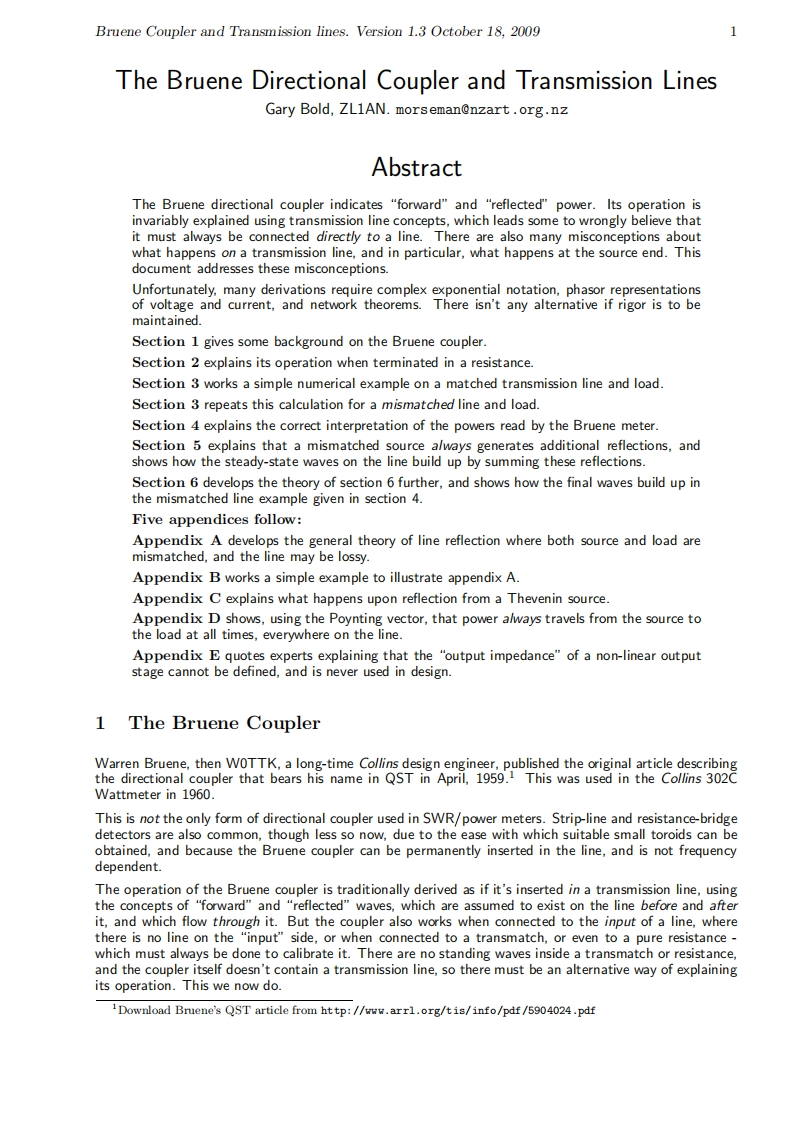

第1页 / 共19页
试读已结束,还剩18页,您可下载完整版后进行离线阅读
THE END
Bruene Coupler and Transmission lines.Version 1.3 October 18,20091The Bruene Directional Coupler and Transmission LinesGary Bold,ZL1AN.morseman@nzart.org.nzAbstractThe Bruene directional coupler indicates "forward"and "reflected"power.Its operation isinvariably explained using transmission line concepts,which leads some to wrongly believe thatit must always be connected directly to a line.There are also many misconceptions aboutwhat happens on a transmission line,and in particular,what happens at the source end.Thisdocument addresses these misconceptions.Unfortunately,many derivations require complex exponential notation,phasor representationsof voltage and current,and network theorems.I here isn't any alternative if rigor is to bemaintained.Section 1 gives some background on the Bruene coupler.Section 2 explains its operation when terminated in a resistance.Section 3 works a simple numerical example on a matched transmission line and load.Section 3 repeats this calculation for a mismatched line and load.Section 4 explains the correct interpretation of the powers read by the Bruene meter.Section 5 explains that a mismatched source a/ways generates additional reflections,andshows how the steady-state waves on the line build up by summing these reflections.Section 6 develops the theory of section 6 further,and shows how the final waves build up inthe mismatched line example given in section 4.Five appendices follow:Appendix A develops the general theory of line reflection where both source and load aremismatched,and the line may be lossy.Appendix B works a simple example to illustrate appendix A.Appendix C explains what happens upon reflection from a Thevenin source.Appendix D shows,using the Poynting vector,that power always travels from the source tothe load at all times,everywhere on the line.Appendix E quotes experts explaining that the "output impedance"of a non-linear outputstage cannot be defined,and is never used in design.1 The Bruene CouplerWarren Bruene,then WOTTK,a long-time Collins design engineer,published the original article describingthe directional coupler that bears his name in QST in April,1959.This was used in the Collins 302CWattmeter in 1960.This is not the only form of directional coupler used in SWR/power meters.Strip-line and resistance-bridgedetectors are also common,though less so now,due to the ease with which suitable small toroids can beobtained,and because the Bruene coupler can be permanently inserted in the line,and is not frequencydependent.The operation of the Bruene coupler is traditionally derived as if it's inserted in a transmission line,usingthe concepts of "forward"and "reflected"waves,which are assumed to exist on the line before and afterit,and which flow through it.But the coupler also works when connected to the input of a line,wherethere is no line on the "input"side,or when connected to a transmatch,or even to a pure resistance-which must always be done to calibrate it.There are no standing waves insi


请登录后查看评论内容